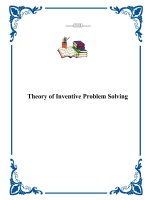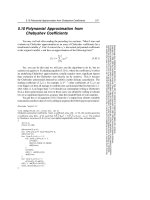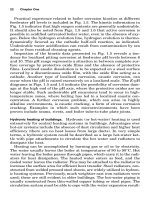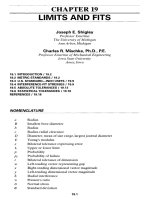Tài liệu Theory of Inventive Problem Solving pdf
Bạn đang xem bản rút gọn của tài liệu. Xem và tải ngay bản đầy đủ của tài liệu tại đây (297.57 KB, 30 trang )
----------
Theory of Inventive Problem Solving
Theory of Inventive Problem Solving (TRIZ)
1.0 Introduction
Following World War II, the high quality, technologically advanced products of the United States
dominated world markets. With the oil shock of the 1970s, however, many of the economic
advantages associated with cheap petroleum were lost and the recovered economies of Europe and
Asia emerged as strong competitors in many product areas. The innovative technologies of the US
could no longer insulate industries from the customer oriented approaches of European and Asian
producers.
The 1990s have seen the recovery of many US industries, most notably the automotive industry.
This has been due in part to the influence of many Japanese quality methodologies introduced here
by the late Dr. Kaoru Ishikawa, Dr. Masao Kogure, Dr. Yoji Akao, Dr. Noriaki Kano, Mr. Masaaki
Imai, and many others. These quality methods have helped US industries reduce defects, improve
quality, lower costs, and become more customer focused. As the quality gap with countries like
Japan gets smaller, the US is looking for new approaches to assure customer satisfaction, reduce
costs, and bring products to the market faster. In the US, we say "better, cheaper, faster."
While there are many widely used design and development approaches such as Quality Function
Deployment, these show us what to solve but not always how to solve the technology bottlenecks
that arise. One technique, the Reviewed Dendrogram, relies on the experience of designers which
may be limited to certain areas of expertise such as chemistry or electronics. Thus, a solution that
might be simpler and cheaper using magnetism could be missed. For example, a materials engineer
searching for a dampener may limit his search to rubber based materials. A more efficient solution
might lie in creating a magnetic field. Since this is outside the experience of the engineer, how could
he imagine such a solution? Using TRIZ, he would be able to explore design solutions in fields other
than his own.
Rockwell International's Automotive Division faced a problem like this. They were losing a
competitive battle with a Japanese company over the design of brakes for a golf cart. Since both
Rockwell and the Japanese competitor were in the automotive field, they were competing on
redesigns of an automobile brake system but with smaller components. In TRIZ, this seeking
solutions only in one's field is called "psychological inertia" because it is natural for people to rely
on their own experience and not think outside their specialty. With TRIZ, the problem was solved by
redesigning a bicycle brake system with larger components. The result was a part reduction from
twelve to four parts and a cost savings of 50%.
2.0 The History of TRIZ
There are two groups of problems people face: those with generally known solutions and those with
unknown solutions. Those with known solutions can usually be solved by information found in
books, technical journals, or with subject matter experts. These solutions follow the general pattern
of problem solving shown in figure 1. Here, the particular problem is elevated to a standard problem
of a similar or analogous nature. A standard solution is known and from that standard solution
comes a particular solution to the problem. For example, in designing a rotating cutting machine(my
problem), a powerful but low 100 rpm motor is required. Since most AC motors are high rpm (3600
rpm), the analogous standard problem is how to reduce the speed of the motor. The analogous
standard solution is a gear box or transmission. Then, a gear box can be designed with appropriate
dimensions, weight, rpm, torque, etc. can be designed for my cutting needs.
Figure 1. General Problem Solving Model.
2.1 Inventive Problems
The other type of problem is one with no known solution. It is called an inventive problem and may
contain contradictory requirements. As long ago as the 4
th
century, an Egyptian scientist named Papp
suggested there should be a science called heuristics to solve inventive problems. In modern times,
inventive problem solving has fallen into the field of psychology where the links between the brain
and insight and innovation are studied. Methods such as brainstorming and trial-and-error are
commonly suggested. Depending on the complexity of the problem, the number of trials will vary. If
the solution lies within one's experience or field, such as mechanical engineering, than the number
of trials will be fewer. If the solution is not forthcoming, then the inventor must look beyond his
experience and knowledge to new fields such as chemistry or electronics. Then the number of trials
will grow large depending on how well the inventor can master psychological tools like
brainstorming, intuition, and creativity. A further problem is that psychological tools like experience
and intuition are difficult to transfer to other people in the organization.
This leads to what is called psychological inertia, where the solutions being considered are within
one's own experience and do not look at alternative technologies to develop new concepts. This is
shown by the psychological inertia vector in figure 2.
Figure 2. Limiting Effects of Psychological Inertia.
When we overlay the limiting effects of psychological inertia on a solution map covering broad
scientific and technological disciplines, we find that the ideal solution may lie outside the inventor's
field of expertise. This is seen in figure 3 where the ideal solution is electromechanical but is outside
the experience of the mechanical engineer and so remains untried and may even be invisible. If
problem solving was a random process, then we would expect solutions to occur randomly across
the solution space. Psychological inertia defeats randomness and leads to looking only where there
is personal experience.
Figure 3. Ideal Solution May Be Outside Your Field.
2.2 Genrich S. Altshuller, the Father of TRIZ
A better approach, relying not on psychology but on technology was developed by Genrich S.
Altshuller, born in the former Soviet Union in 1926. His first invention, for scuba diving, was when
he was only 14 years old. His hobby led him to pursue a career as a mechanical engineer. Serving in
the Soviet Navy as a patent expert in the 1940s, his job was to help inventors apply for patents. He
found, however, that often he was asked to assist in solving problems as well. His curiosity about
problem solving led him to search for standard methods. What he found were the psychological
tools that did not meet the rigors of inventing in the 20
th
century. At a minimum, Altshuller felt a
theory of invention should satisfy the following conditions:
1. be a systematic, step-by-step procedure
2. be a guide through a broad solution space to direct to the ideal solution
3. be repeatable and reliable and not dependent on psychological tools
4. be able to access the body of inventive knowledge
5. be able to add to the body of inventive knowledge
6. be familiar enough to inventors by following the general approach to problem solving in
figure 1.
In the next few years, Altshuller screened over 200,000 patents looking for inventive problems and
how they were solved. Of these (over 1,500,000 patents have now been screened), only 40,000 had
somewhat inventive solutions; the rest were straight forward improvements. Altshuller more clearly
defined an inventive problem as one in which the solution causes another problem to appear, such as
increasing the strength of a metal plate causing its weight to get heavier. Usually, inventors must
resort to a trade-off and compromise between the features and thus do not achieve an ideal solution.
In his study of patents, Altshuller found that many described a solution that eliminated or resolved
the contradiction and required no trade-off.
Altshuller categorized these patents in a novel way. Instead of classifying them by industry, such as
automotive, aerospace, etc., he removed the subject matter to uncover the problem solving process.
He found that often the same problems had been solved over and over again using one of only forty
fundamental inventive principles. If only later inventors had knowledge of the work of earlier ones,
solutions could have been discovered more quickly and efficiently.
In the 1960s and 1970s, he categorized the solutions into five levels.
• Level one. Routine design problems solved by methods well known within the specialty. No
invention needed. About 32% of the solutions fell into this level.
• Level two. Minor improvements to an existing system, by methods known within the
industry. Usually with some compromise. About 45% of the solutions fell into this level.
• Level three. Fundamental improvement to an existing system, by methods known outside the
industry. Contradictions resolved. About 18% of the solutions fell into this category.
• Level four. A new generation that uses a new principle to perform the primary functions of
the system. Solution found more in science than in technology. About 4% of the solutions
fell into this category.
• Level five. A rare scientific discovery or pioneering invention of essentially a new system.
About 1% of the solutions fell into this category.
He also noted that with each succeeding level, the source of the solution required broader knowledge
and more solutions to consider before an ideal one could be found. His findings are summarized in
Table 1.
Table 1. Levels of Inventiveness.
Level
Degree of
inventiveness
% of solutions Source of knowledge
Approximate #
of solutions to
consider
1
Apparent
solution
32% Personal knowledge 10
2
Minor
improvement
45%
Knowledge within
company
100
3
Major
improvement
18%
Knowledge within the
industry
1000
4 New concept 4%
Knowledge outside
the industry
100,000
5 Discovery 1% All that is knowable 1,000,000
What Altshuller tabulated was that over 90% of the problems engineers faced had been solved
somewhere before. If engineers could follow a path to an ideal solution, starting with the lowest
level, their personal knowledge and experience, and working their way to higher levels, most of the
solutions could be derived from knowledge already present in the company, industry, or in another
industry.
For example, a problem in using artificial diamonds for tool making is the existence of invisible
fractures. Traditional diamond cutting methods often resulted in new fractures which did not show
up until the diamond was in use. What was needed was a way to split the diamond crystals along
their natural fractures without causing additional damage. A method used in food canning to split
green peppers and remove the seeds was used. In this process, peppers are placed in a hermetic
chamber to which air pressure is increased to 8 atmospheres. The peppers shrink and fracture at the
stem. Then the pressure is rapidly dropped causing the peppers to burst at the weakest point and the
seed pod to be ejected. A similar technique applied to diamond cutting resulted in the crystals
splitting along their natural fracture lines with no additional damage.
Altshuller distilled the problems, contradictions, and solutions in these patents into a theory of
inventive problem solving which he named TRIZ.
3.0 TRIZ:
The Theory of Inventive Problem Solving
There are a number of laws in the theory of TRIZ. One of them is the Law of Increasing Ideality.
This means that technical systems evolve toward increasing degrees of ideality, where ideality is
defined as the quotient of the sum of the system's useful effects, U
i
, divided by the sum of its
harmful effects, H
j
.
Useful effects include all the valuable results of the system's functioning. Harmful effects include
undesired inputs such as cost, footprint, energy consumed, pollution, danger, etc. The ideal state is
one where there are only benefits and no harmful effects. It is to this state that product systems will
evolve. From a design point of view, engineers must continue to pursue greater benefits and reduce
cost of labor, materials, energy, and harmful side effects. Normally, when improving a benefit
results in increased harmful effects, a trade-off is made, but the Law of Ideality drives designs to
eliminate or solve any trade-offs or design contradictions. The ideal final result will eventually be a
product where the beneficial function exists but the machine itself does not. The evolution of the
mechanical spring-driven watch into the electronic quartz crystal watch is an example of moving
towards ideality.
3.1 The TRIZ Process Step-By-Step
As mentioned above, Altshuller felt an acceptable theory of invention should be familiar enough to
inventors by following the general approach to problem solving shown in figure 1. A model was
constructed as shown in figure 4.
Figure 4. TRIZ Approach to Problem Solving.
3.1.1 Step 1. Identifying My Problem.
Boris Zlotin and Alla Zusman, principles TRIZ scientists at the American company Ideation and
students of Altshuller have developed an "Innovative Situation Questionnaire" to identify the
engineering system being studied, its operating environment, resource requirements, primary useful
function, harmful effects, and ideal result.
Example: A beverage can. An engineered system to contain a beverage. Operating
environment is that cans are stacked for storage purposes. Resources include weight of filled
cans, internal pressure of can, rigidity of can construction. Primary useful function is to
contain beverage. Harmful effects include cost of materials and producing can and waste of
storage space. Ideal result is a can that can support the weight of stacking to human height
without damage to cans or beverage in cans.
3.1.2 Formulate the problem: the Prism of TRIZ
Restate the problem in terms of physical contradictions. Identify problems that could occur. Could
improving one technical characteristic to solve a problem cause other technical characteristics to
worsen, resulting in secondary problems arising? Are there technical conflicts that might force a
trade-off?
Example: We cannot control the height to which cans will be stacked. The price of raw
materials compels us to lower costs. The can walls must be made thinner to reduce costs, but if
we make the walls thinner, it cannot support as large a stacking load. Thus, the can wall needs
to be thinner to lower material cost and thicker to support stacking-load weight. This is a
physical contradiction. If we can solve this, we will achieve an ideal engineering system.
3.1.3 Search for Previously Well-Solved Problem
Altshuller extracted from over 1,500,000 world-wide patents these 39 standard technical
characteristics that cause conflict. These are called the 39 Engineering Parameters shown in Table 2.
Find the contradicting engineering principles. First find the principle that needs to be changed. Then
find the principle that is an undesirable secondary effect. State the standard technical conflict.
Example. The standard engineering parameter that has to be changed to make the can wall
thinner is "#4, length of a nonmoving object." In TRIZ, these standard engineering principles
can be quite general. Here, "length" can refer to any linear dimension such as length, width,
height, diameter, etc. If we make the can wall thinner, stacking-load weight will decrease. The
standard engineering parameter that is in conflict is "#11, stress."
The standard technical conflict is: the more we improve the standard engineering parameter
"length of a nonmoving object," the more the standard engineering parameter "stress"
becomes worse.
Table 2. The 39 Engineering Parameters
1. Weight of moving object
2. Weight of nonmoving object
3. Length of moving object
4. Length of nonmoving object
5. Area of moving object
6. Area of nonmoving object
7. Volume of moving object
8. Volume of nonmoving object
9. Speed
10. Force
11. Tension, pressure
12. Shape
13. Stability of object
14. Strength
15. Durability of moving object
16. Durability of nonmoving object
17. Temperature
18. Brightness
19. Energy spent by moving object
20. Energy spent by nonmoving object
21. Power
22. Waste of energy
23. Waste of substance
24. Loss of information
25. Waste of time
26. Amount of substance
27. Reliability
28. Accuracy of measurement
29. Accuracy of manufacturing
30. Harmful factors acting on object
31. Harmful side effects
32. Manufacturability
33. Convenience of use
34. Repairability
35. Adaptability
36. Complexity of device
37. Complexity of control
38. Level of automation
39. Productivity
3.1.4. Look for Analogous Solutions and Adapt to My
Solution
Altshuller also extracted from the world wide patents 40 inventive principles. These are hints that
will help an engineer find a highly inventive (and patentable) solution to the problem. Examples
from patents are also suggested with these 40 inventive principles. See Table 3. To find which
inventive principles to use, Altshuller created the Table of Contradictions, Table 4. The Table of
Contradictions lists the 39 Engineering Parameters on the X-axis (undesired secondary effect) and
Y-axis (feature to improve). In the intersecting cells, are listed the appropriate Inventive Principles
to use for a solution.
Example. The engineering parameters in conflict for the beverage can are "#4, length of a
nonmoving object" and "#11, stress." The feature to improve (Y-axis) is the can wall thickness
or "#4, length of a nonmoving object" and the undesirable secondary effect (X-axis) is loss of
load bearing capacity or "#11, stress." Looking these up on the Table of Contradictions, we
find the numbers 1, 14, and 35 in the intersecting cell.
Inventive Principle #1 is
Segmentation
a. Divide an object into independent parts
b. Make an object sectional
c. Increase the degree of an object's segmentation
Examples:
• Sectional furniture, modular computer components, folding wooden ruler
• Garden hoses can be joined together to form any length needed
For example, using Inventive Principle 1 c. "Increase the degree of an object's segmentation,"
the wall of the can could be changed from one smooth continuous wall to a corrugated or wavy
surface made up of many "little walls." This would increase the edge strength of the wall yet
allow a thinner material to be used. See figure 5.
Figure 5. Cross section of corrugated can wall.
Inventive Principle # 14 is
Spheroidality
a. Replace linear parts or flat surfaces with curved ones; replace cubical shapes with spherical shapes
b. Use rollers, balls spirals
c. Replace a linear motion with rotating movement; utilize a centrifugal force
Example:
• Computer mouse utilized ball construction to transfer linear two-axis motion into vector
motion
Using Inventive Principle 14 a., the perpendicular angle at which most can lids are welded to
the can wall can be changed to a curve. See figure 6.
Figure 6. Spheroidality Strengthens Can's Load Bearing Capacity.
Perpendicular angle has been replaced with a curve.
Inventive Principle #35 is
Transformation of the physical and chemical states of an object
Change an object's aggregate state, density distribution, degree of flexibility, temperature
Example:
• In a system for brittle friable materials, the surface of the spiral feedscrew was made from an
elastic material with two spiral springs. To control the process, the pitch of the screw could
be changed remotely.
Change the composition to a stronger metal alloy used for the can wall to increase the load
bearing capacity.
In less than one week, the inventor Jim Kowalik of Renaissance Leadership Institute was able to
propose over twenty usable solutions to the U.S. canned beverage industry, several which have been
adopted.
Table 3. The 40 Inventive Principles.
1. Segmentation
a. Divide an object into independent parts
b. Make an object sectional
c. Increase the degree of an object's segmentation
Examples:
• Sectional furniture, modular computer components, folding wooden ruler









